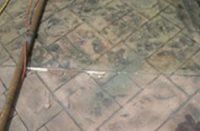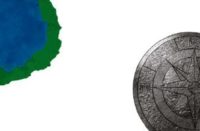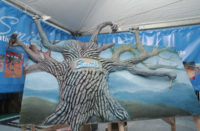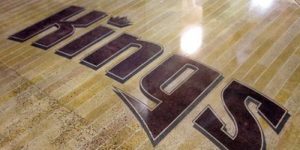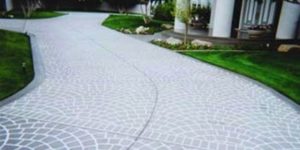For years, it seemed to me that people thought stenciled concrete was the bastard child of decorative concrete. I never really understood that.
Back in those days the slightest mention of stenciled concrete would bring up an argument about how somehow it was an inferior product compared to stamped or imprinted concrete. I never could figure this out. To me stenciled concrete appears more realistic than stamped or imprinted concrete, and I knew it was less expensive than properly installed pavers or natural materials like flagstone.
I would also see contractors engraving existing concrete and loving it. It looked liked stenciled concrete to me, but without any texture. I loved it engraved or stenciled.
A main benefit of engraving is that, if you stain concrete and then engrave it, the result will have a different-colored grout line because you engraved through the stain to the natural gray concrete. If you put down a stencil when a pour or overlay is fresh, you can get the different-colored grout line and texture too, which gives you a much more authentic, realistic look.
When I have a customer come to my shop to look at samples of say herringbone, I show both a stenciled and a stamped sample. I always point out the different-colored grout or joint line, and I would bet that 90 percent of the time, she will say, “How much more for the stenciled sample with the different-colored grout line?”
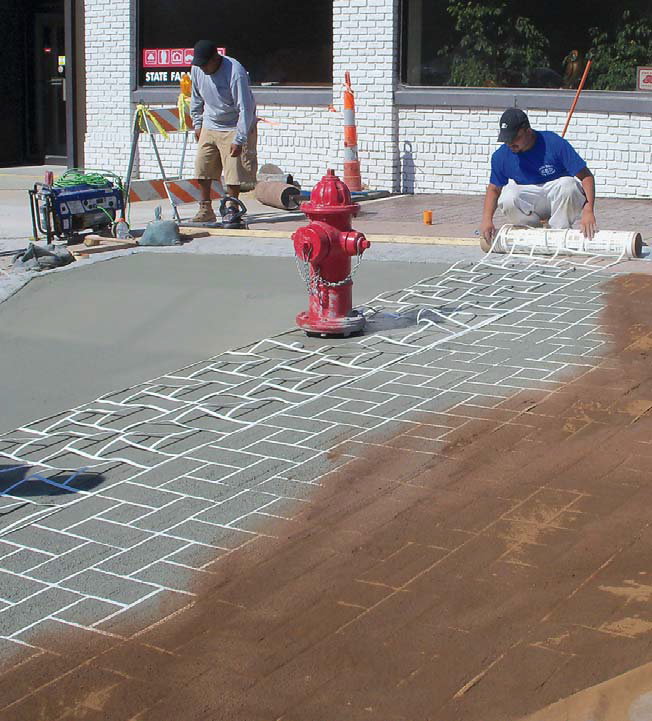
I say, “About 75 cents or so per square foot.” According to the psychology of pricing, this often tells the consumer the higher-priced item has more value. That extra 75 cents more than pays for your stencil and hopefully gives something back to you as well.
Stenciled concrete is conducive to many textures, whether smooth to seamless textured skins, a broom finish, or a texture roller. Gone are the days of getting 12 to 15 stamps at $150 per stamp and nailing just the right timing to produce a constant texture through the pour. Gone are the days of different colors because this truck or load was stamped earlier or later, causing a color difference.
Here are five more things I’ve observed about the business of stenciled concrete:
1. Stenciling helps you set yourself apart from the competition. If everyone in your market is stamping, then stenciling will immediately set you apart from everyone else. Stamping has been around for quite awhile, and architects, designers and landscapers are looking for something fresh and new. Don’t just wait for them to discover stenciled concrete. Make samples, do architectural presentations and price a good discount.
At first, you want to put stenciled concrete where the public can see it and it will sell itself. Once you have done that, always price your stenciled concrete more than your stamped.
2. Municipalities and commercial establishments love stenciled concrete. It is not as slippery as a lot of stamped concrete. My number one complaint about stamped concrete is that it is often slippery when wet. Because stenciled concrete has a flatter plane than stamped concrete does, it is less slippery. We have all seen those specs of porte-cocheres with canyon or random-stone stamps that we know people often have difficulty maneuvering.
Lincoln, Neb., specs a lot of stenciled concrete for its crosswalks. Stenciled concrete crosswalks and landings are easier for the visually impaired and physically handicapped to get across. The city also loves them because the flatter plane allows for easier snow removal.
My second biggest complaint about stamped concrete is that it is sometimes fake or plastic-looking. Stenciled concrete often looks much more authentic than stamped.
3. Entering the stenciled concrete market costs less than becoming a stamper. You can enter the stenciled concrete market for a fraction of the capital needed to get into the stamped concrete market.
For each stamped concrete pattern, you as a contractor will invest a minimum of about $1,500, depending on the manufacturer. I have access to 32 stencil patterns plus more for bands or borders — your count will depend on the stencil manufacturer you use. My cost is around $300 for 1,000 square feet. If I were to have to invest in 32 different patterns in stamps I would be looking at investing tens of thousands of dollars, and in these times that is difficult.
4. You can pour more stenciled concrete with less labor. It is possible to pour more stenciled concrete with less labor compared to stamped concrete.
Pouring 600 square feet with color hardener and stamping with an ashlar slate pattern is pretty difficult and time-consuming. Pouring that same 600 square feet and stenciling requires much less skilled labor. Once the stencil is placed and color has been thrown, it takes about 15 to 20 minutes to texture. There is just no way stamping 600 square feet can be done as efficiently. I know these are lofty claims, but once you get the basics of stenciling you can really move. It takes years to get good at stamping.
5. With stenciled concrete you can complete in one day. It is possible with stenciled concrete to complete the entire operation, minus grading and forming, in one day. This is an advanced process. When using admixtures such as superplasticizers, midrange plasticizers, nonchloride accelerators, concrete delay admixtures and evaporation retardants to manipulate the concrete, you can easily pour, stencil, color, texture and seal in one day. The use of liquid release helps make this possible.
Another thing I like about stenciled concrete is I can often incorporate multiple colors and even textures into one pour without extra forming.
